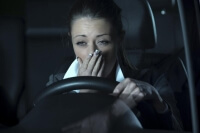This week is Drowsy Driving Prevention Week (DDPW). We always hear about falling asleep behind the wheel, but is it really that common?

The National Sleep Foundation conducted a poll and found that about 60% of Americans have gotten behind the wheel despite feeling drowsy, and nearly 40% of those drivers have fallen asleep while driving.
Most of these drivers quickly wake back up after drifting onto rumble strips, but still, others aren't so lucky.
Drowsy driving causes more than 71,000 serious injuries per year, and roughly 1,600 deaths.
But unlike driving under the influence, there's no “test” police can use to determine whether drowsiness played a factor in any given accident. Because these numbers are self-reported, it's likely that many more crashes could be related to falling asleep behind the wheel.
Studies have found that driving while sleepy can be just as dangerous as driving drunk. Being awake for just 18-24 hours can result in driving impairment similar to 0.1% blood alcohol content (over the legal limit).
Luckily, driving drowsy is easily preventable. Drifting out of your lane, yawning or blinking excessively, missing your exit, and drifting onto rumble strips are all warning signs of drowsy driving. When you're feeling tired, it's better to take a nap and plan accordingly than to keep driving and risk having an accident.
As part of DDPW, do your part to stop sleep-related crashes on the road. If possible, avoid driving late at night or very early in the morning. Use these resources to stay safe on the road, and keep the roadways safe for the rest of our community, too.
#drowsydriving #ddpw

